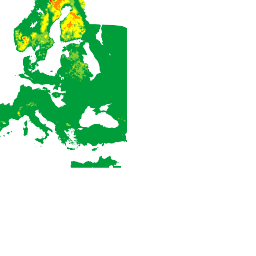Chỉ số phấn hoa toàn cầu (UPI) là gì?
Chỉ số phấn hoa toàn cầu (UPI) được thiết kế để cung cấp một thang đo thống nhất trên toàn cầu nhằm so sánh mức phấn hoa ở nhiều khu vực. Chỉ số này giúp đánh giá nguy cơ tiếp xúc với phấn hoa dựa trên nhiều yếu tố đối với những người bị dị ứng hoặc nhạy cảm với phấn hoa. Dựa trên mô hình nhiều lớp, đây là một bản trình bày dữ liệu về mức độ phấn hoa, có tính đến nồng độ trên mỗi mô hình thực vật, nhiều chỉ số phấn hoa địa phương (LPI) khác nhau được sử dụng trên toàn thế giới và khả năng gây dị ứng của các loại phấn hoa thực vật khác nhau để dự đoán số lượng hạt phấn hoa trên mỗi mét khối (hạt/m3) mỗi ngày.
Điểm cuối heatmapTiles trả về các ô bản đồ nhiệt có thể được phủ lên một bản đồ cơ sở. Ô bản đồ nhiệt hiển thị UPI trên toàn cầu cho một loại cây nhất định (TREE, GRASS hoặc WEED).
Chỉ số này bao gồm 6 danh mục:
| Giá trị | Màu | Mô tả |
|---|---|---|
| 0 | Không có | |
| 1 | Rất thấp | |
| 2 | Thấp | |
| 3 | Vừa phải | |
| 4 | Cao | |
| 5 | Rất cao |
Mỗi danh mục dựa trên nồng độ phấn hoa cụ thể ở một khu vực nhất định và ảnh hưởng của chúng đến mức độ nghiêm trọng của các triệu chứng dị ứng thường gặp, cung cấp thông tin toàn diện về nồng độ phấn hoa. Bằng cách tích hợp UPI, người dùng có thể so sánh và đánh giá tình trạng phấn hoa ở nhiều địa điểm.
Ví dụ: ô bản đồ nhiệt sau đây cho thấy mức phấn hoa TREE dao động từ Rất thấp đến Rất cao:

Các loại cây được hỗ trợ
Pollen API hỗ trợ 3 loại thực vật: Cỏ, Cỏ dại và Cây. Vì tính sẵn có của một loài thực vật phụ thuộc vào các phép đo và báo cáo của nguồn dữ liệu thực tế, nên dữ liệu về thực vật của Pollen API có thể khác nhau ở các vị trí.
Danh sách sau đây cho thấy các mã nhà máy được hỗ trợ và siêu dữ liệu của các mã đó:
| Mã nhà máy | Tên hiển thị | Loại |
|---|---|---|
ALDER |
Alder | Cây |
ASH |
Ash | Cây |
BIRCH |
Màu bạch dương | Cây |
COTTONWOOD |
Cottonwood | Cây |
ELM |
Elm | Cây |
MAPLE |
Cây phong | Cây |
OLIVE |
Olive | Cây |
JUNIPER |
Juniper | Cây |
OAK |
Gỗ sồi | Cây |
PINE |
Màu xanh lá thông | Cây |
CYPRESS_PINE |
Cây bách thông | Cây |
HAZEL |
Nâu hạt dẻ | Cây |
GRAMINALES |
Cỏ | Cỏ |
JAPANESE_CEDAR |
Cây liễu sam Nhật | Cây |
JAPANESE_CYPRESS |
Cây bách Nhật Bản | Cây |
RAGWEED |
Cỏ phấn hương | Cỏ dại |
MUGWORT |
Ngải cứu | Cỏ dại |

